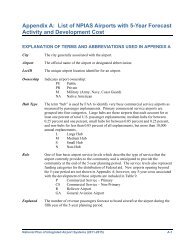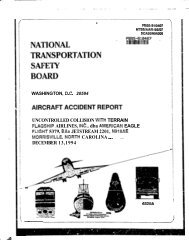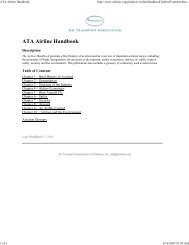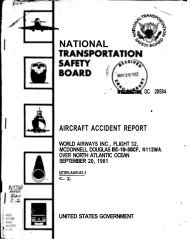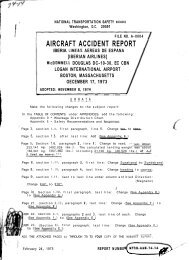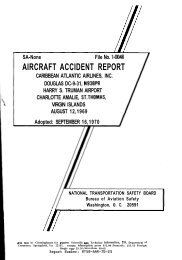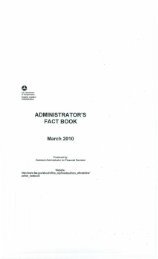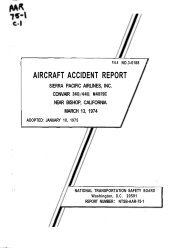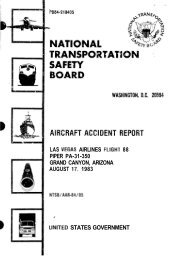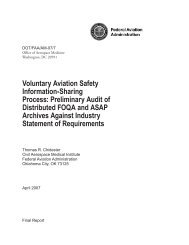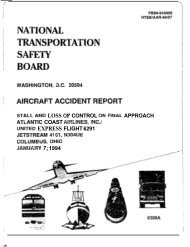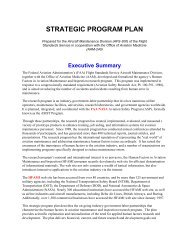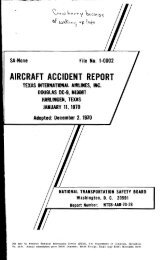Ntsb/aar-79-01 - AirDisaster.Com
Ntsb/aar-79-01 - AirDisaster.Com
Ntsb/aar-79-01 - AirDisaster.Com
You also want an ePaper? Increase the reach of your titles
YUMPU automatically turns print PDFs into web optimized ePapers that Google loves.
- 19 -<br />
For the conditions set forth in the airworthiness standards,<br />
engine failure on a dry runway, the accelerate-stop distance for<br />
Flight 603 was calculated to be 9,450 ft, with 5,980 ft required for<br />
acceleration to V1 and 3,470 ft required to stop the aircraft. These<br />
distances were derived from actual rejected takeoff data developed<br />
during aircraft certification flight tests. When compared to the total<br />
runway length, this distance would provide 835 ft of stopping margin on<br />
runway 6R under dry conditions. The calculated accelerate-stop distance<br />
for a rejected takeoff with a failed engine on a wet runway was 10,300 ft,<br />
4,320 ft of which would have been required for stopping. Therefore, the<br />
estimated stopping distance on a wet runway is 850 ft more than the<br />
stopping distance required for the dry runway. Essentially, this means<br />
that a DC-10 aircraft could have stopped on the wet runway with one<br />
failed engine, with normal tires and maximum braking. Allowing for fan<br />
reversers, a 600-ft stopping distance margin would be provided.<br />
14 CFR 25 states further that means other than wheel brakes<br />
may be used to determine the accelerate-stop distance if that means:<br />
(1) is safe and reliable, (2) is used so that consistent results can be<br />
expected under normal operating conditions, and (3) is such that exceptional<br />
skill is not required to control the airplane. The engine fan and turbine<br />
thrust reversers provide an operational safety margin, because they<br />
reduce the dry runway stopping distances determined during certification<br />
testing. However, currently FAA disallows reverse thrust credit in<br />
determining accelerate-stop distances, because thrust reverser systems<br />
have not fully met these criteria. Therefore, many operators of wide<br />
body aircraft have disconnected the turbine reversers, a portion of the<br />
reverser system, because they have not been reliable and maintenance<br />
difficulties have been encountered. The accident aircraft did not have<br />
operable turbine reversers to augment the engine fan reversers nor were<br />
they required to be operable under current regulations.<br />
The effect of three turbine reversers on the wet stopping<br />
distance was calculated. Calculations indicated that these reversers<br />
would reduce the fan-reverser-only stopping distance by 600 ft. Applying<br />
actual braking coefficients and crew reaction times, turbine reversers<br />
could have reduced the actual runway overrun speed in this accident from<br />
68 kns to about 20 kns. This lower overrun speed would have allowed the<br />
aircraft to stop 100 ft beyond the end of the runway, which would have<br />
drastically reduced the severity of the accident.<br />
Re Safety Board recognizes that calculations based on the<br />
NASA DBV data are estimates only. However, these estimates have allowed<br />
reasonable assessments to be made of the relative value each parameter<br />
contributes to stopping performance. No alternative analytical techniques<br />
or actual flight test data were available to the Board to otherwise<br />
estimate the aircraft's wet runway stopping performance from actual<br />
runway friction measurements.<br />
I



